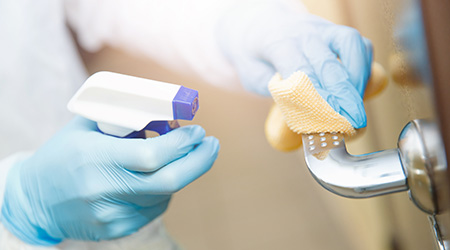Candida auris, or C. auris, is a superbug that evades the drugs designed to kill it. The fungal pathogen clings to surfaces and requires specific disinfectants to kill it — ones not currently being used in most facilities focusing on COVID-19. Because of these, the superbug easily passes from one person to another. With hospital occupancy on the rise again because of the coronavirus, C. auris is prominent in healthcare settings.
Environmental services and facility teams can follow these steps to help prevent the spread of this new superbug.
-
Check for a kill-claim for C-auris on the hospital-approved hand sanitizer. If the alcohol-based hand sanitizer does not have a kill-claim for the fungal pathogen, Safety and Risk Management will need to perform and document an infection prevention assessment that reflects their infection prevention strategy for hand hygiene in the event of a C. auris outbreak.
-
Choose a disinfectant from the EPA’s List K with the shortest, most realistic dwell time. The list with kill claims against C. diff Spores shows some products but may not be complete or up to date. It is best to check the disinfectant’s EPA Master Label listing of all microorganism kill claims. Do not use a product with C. albicans or other fungicidal claims if they are not on List K. They may not be effective due to an unreasonable 10-minute contact time.
-
Hospitals should have a defined process for notifying Environmental Services leaders when patients with C. auris are isolated. Be sure to include Radiology, Nursing Department, and the Emergency Department in your planning. Nursing staff are usually responsible for cleaning and disinfecting patient care equipment. They are key partners in controlling and preventing the spread of C. auris by thoroughly cleaning and disinfecting equipment as it moves between patients.
-
Before using one of the disinfectants from List K on patient care equipment, a check for material compatibility needs to be performed. While the benefits of contact time and efficacy are clear, the issue of material compatibility and its importance are worth a deeper dive. The equipment manufacturer’s instructions for cleaning and disinfecting their product will be a valuable resource. If there are conflicts between those instructions and the disinfectant’s label, those conflicts need to be resolved with an infection prevention risk assessment by Safety and Risk Management leaders.
-
Patients with confirmed or suspected C. auris infection should be placed in isolation until discharged or the condition is resolved.
-
Isolated patients’ rooms should be processed twice daily by EVS on the a.m. and p.m. shifts. Maintain a record of these extra touches.
-
Through observation by an EVS department leader, ensure that EVS personnel don and doff required Personal Protective Equipment (PPE) per hospital protocols.
-
The processing of rooms vacated because the isolated patient was discharged or transferred should follow the department’s protocols for isolation rooms. In addition, the patient’s bed should be meticulously processed. The mattress should be: 1. Cleaned with a general-purpose cleaning solution; 2. Rinsed with clean water and dried; 3. Disinfected with a disinfectant from the EPA List K and allowed to air dry; 4. After the mattress has dried, rinse with clean water before making the bed with clean linens.
-
Change the privacy curtains.
-
Disinfect the floor.
Additionally, if you employ total room disinfection utilizing UV or hydrogen peroxide vapor, check with the manufacturer to determine if it is necessary to change EVS department protocols for elimination of C-auris. Get those recommendations in writing as you develop a department-specific policy.
With the option for effective antifungal medications narrowing, the CDC recommends a focus on stopping C. auris infections before they start. These steps include rapid detection of the disease, better hand hygiene and safe, clean and disinfected surfaces.
In December of 2019 news emerged of a novel virus, SARS-CoV-2. Since then, most of us have been watching the terrifying headlines about the global pandemic, which has killed millions. But while we have been isolating ourselves in lockdown or quarantine, or just remaining physically distant from one another, the multidrug-resistant microbes of the world — including C. auris have not.
J. Darrel Hicks, BA, MESRE, CHESP, Certificate of Mastery in Infection Prevention is the Past President of the Healthcare Surfaces Institute. Hicks is nationally recognized as a subject matter expert in infection prevention and control as it relates to cleaning. He is the owner/principal of Safe, Clean and Disinfected. His enterprise specializes in B2B consulting, webinar presentations, seminars and facility consulting services related to cleaning and disinfection. He can be reached at darrel@darrelhicks.com or you can learn more at www.darrelhicks.com.

 UF Health Hospitals Rely on Green Globes to Realize Their Full Potential
UF Health Hospitals Rely on Green Globes to Realize Their Full Potential How Healthcare Facilities Can Be Truly Disaster-Resilient
How Healthcare Facilities Can Be Truly Disaster-Resilient TriasMD Breaks Ground on DISC Surgery Center for San Fernando Valley
TriasMD Breaks Ground on DISC Surgery Center for San Fernando Valley Bigfork Valley Hospital Falls Victim to Data Breach
Bigfork Valley Hospital Falls Victim to Data Breach AI-Driven Facilities: Strategic Planning and Cost Management
AI-Driven Facilities: Strategic Planning and Cost Management